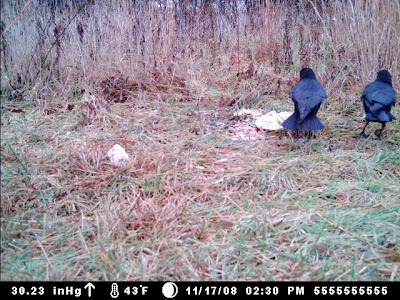 Yesterday was Thanksgiving—the only national American holiday where we all have license to stuff ourselves until we explode. I did. Did you?
Yesterday was Thanksgiving—the only national American holiday where we all have license to stuff ourselves until we explode. I did. Did you?Interestingly the birds at the suet dough station were following suit. Especially the blue jays.
Blue jays are creatures of boom and bust. When they find food in abundance, they load up as much as they can in their large, expandable throat pouches, and take it away to cache. This is a hedge against leaner times ahead, or so the ornithologists tell us. In this way blue jays help keep our forests healthy. They cache thousands of acorns, beechnuts, and other edibles of their choosing. They only remember and re-find and consume a small number of these caches. The forgotten ones may germinate and become trees. In many cases these trees are a long distance away from where they might have grown had they not been transported by the cache-minded jays. This is how jays are unknowing healthy forest helpers.
Had my Wingscapes BirdCam been located at the far end of my parents' dining room table during yesterday's holiday feeding frenzy, I'm not sure the images it captured would have looked very different from the ones below. We staggered home in a food malaise about 8 pm and immediately began groaning and taking Alka Seltzer. My parents, Elsa and Bill, totally out-did themselves. Best gravy ever. Wicked good turkey and taters. Awesome rutabagas. Cherry-custard pie.... I put a hurtin' on it all.
Now I won't have to eat until sometime in mid-December. That's December 2025.
Anyway, check out the blue-crested suet-dough pig of Indigo Hill (the jay—not me).
Happy digesting!












































